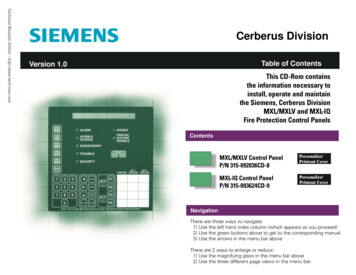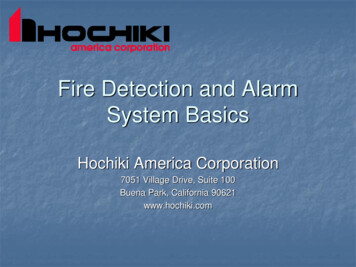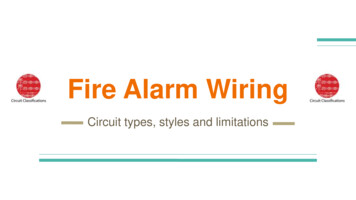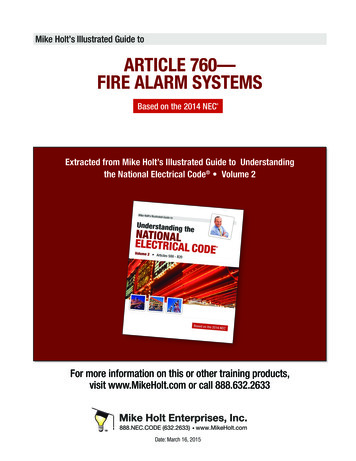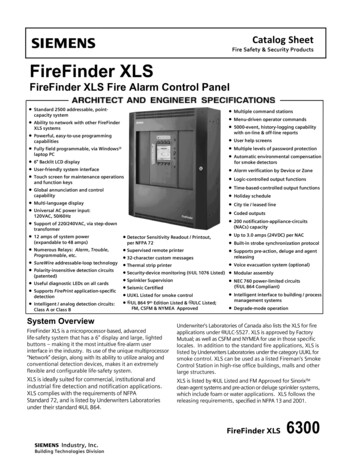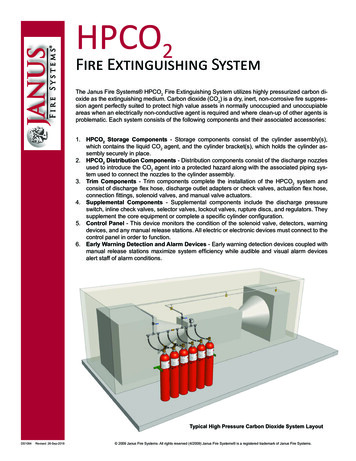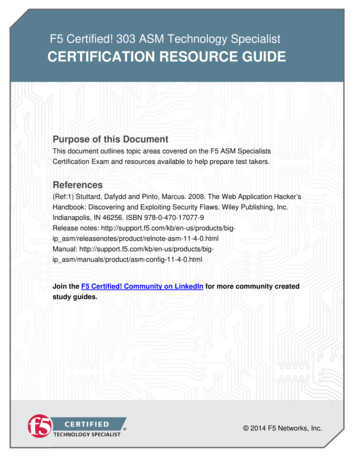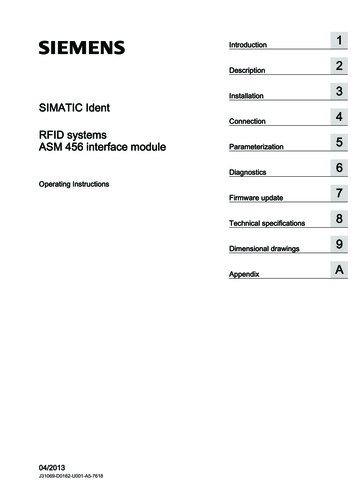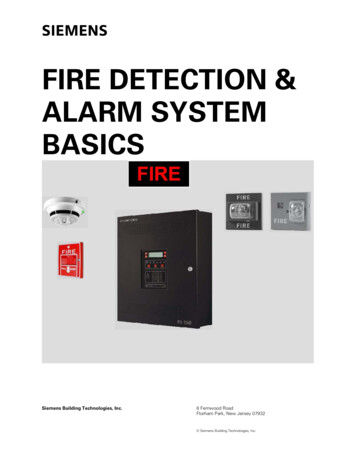
Transcription
SIEMENSFIRE DETECTION &ALARM SYSTEMBASICSSiemens Building Technologies, Inc.8 Fernwood RoadFlorham Park, New Jersey 07932 Siemens Building Technoloiges, Inc.
SIEMENSiiSiemens Building Technologies, Inc
SIEMENSTable of ContentsFire Detection and Alarm System BasicsGeneral System TypesConventional SystemsIntelligent SystemsNFPA System ClassificationsControl PanelSystem Event TypesSupervisionPower SuppliesNotification Appliance CircuitsInitiating Device CircuitsSignaling Line Circuits12236781010101113System InputsManual Fire Alarm StationsInitiating DevicesAlarm Initiating DevicesSmoke DetectorsFlame DetectorsHeat DetectorsFire Sprinkler SystemsWaterflow SwitchesSupervisory Initiating DevicesSprinkler SupervisoryIndustrial Process Supervision1717181920202222232326System OutputsNotification AppliancesControl FunctionsElevator ControlFan ControlDoor ControlBuilding Automation System Interface28282929303132System DesignSmall to Medium SystemsLarge SystemsCentral Control EquipmentDistributed Control EquipmentNetworked Control EquipmentNetworked/Distributed EquipmentSequence of OperationEmergency Voice Communication SystemsOne Way Communications SystemsTwo Way Firefighter Telephone SystemsStand Alone SystemIntegrated Systems34343435363737383939404142Siemens Building Technologies, Inc
SIEMENSAuxiliary Equipment and SystemsNotification Power ExtenderPrintersRemote Annunciators/Remote Control PanelsRemote Status DisplayRemote Diagnostic ModuleDigital CommunicatorsFiber Optic Cable InterfaceDevice Programming ToolNetwork Command CenterVESDAFM-200 Extinguishing SystemCodes and 5Siemens Building Technologies, Inc
SIEMENSFIRE DETECTION AND ALARM SYSTEM BASICSThis course is intended to explain the configuration of automatic fire detection and alarmsystems from a very basic view point.Over the years since automatic fire detection and alarm systems were introduced for generaluse the technology that has been employed has change from a very simple battery poweredelectrical circuit to the systems we have to day which employ many microprocessors(computer chips) to meet the present-day demands. During this presentation the productsreferred to will generally be products offered by Siemens Building Technologies (SBT).MXL-IQFS-250System BasicsA fire detection and alarm system provides audible and visual signals as a result of theoperation of manual or automatic fire alarm initiating devices such as a Manual Fire Alarmstation, smoke detector or heat detector of from other protective equipment such as a firesprinkler system.Manual Fire Alarm Stations (Pull Boxes), Smoke detectors, heat detectors, (Fire Sprinkler)Waterflow switches are initiating devices. Audible devices, like horns, bells, buzzers andchimes and visual signal devices like strobes and signs are all notification appliances.A control panel connects the initiating devices and the notification appliances together to form asystem.The basic fire detection and alarm system consists of the following:1. Control Panel, the center of the system that controls the functions of the system.2. Initiating Devices, the devices that provide the input to the control panel when they areactivated.Siemens Building Technologies, Inc
SIEMENS3. Notification Appliances, the devices that notify the occupants of a building of the firecondition.4. Primary and Secondary Power SuppliesConsider that the function of the fire detection and alarm system is to notify building occupantsof the danger posed by a fire these basic elements makes sense.To gain an understanding of how the system elements work together and some of the otherthings fire detection and alarm systems can do in the event of a fire. The following informationis offered.GENERAL SYSTEM TYPESConventional SystemsThe term conventional system, also known a collective or hardwired system uses initiatingdevices that have only two states, normal and alarm. These initiating devices are connected tocircuits in the control panel and the devices are installed in the building and arranged into zones.The zones are usually used to aid the responding personnel in locating the fire and determiningwhat initiated the alarm. The devices connected to the zones are grouped so that heat andsmoke detectors also called automatic detectors are on different zones that the manual firealarm stations or other initiating devices. Using this method of zoning the areas of the buildingand the devices the conventional system can provide information to the responding personnelas to the location of the fire and the type of device that initiated the alarm. We will go into2Siemens Building Technologies, Inc
SIEMENSinitiating devices in more detail in a later section of this course for now it is OK if youunderstand that they INITIATE the alarm.When the system goes into the alarm state it operates the notification appliances. Thenotification appliances are devices that are used to notify the occupants of the building of thefire condition through audible and visual means. We will go into the notification devices indetail in a later section of the course.The requirements of a fire detection and alarm system to meet codes and standards will alsobe covered in a later section of the course,Intelligent SystemsThe term intelligent Systems refer to the initiating devices attached to the system. TheseIntelligent (Analog/Addressable) initiating devices use a two way communications method tocommunicate with the control panel and can provide much more information than conventionaldevices (normal/alarm state). The most important information is the device ID which throughthe control panel provides the responding personnel with the device type and exact location inthe property. Additionally the intelligent devices can provide information to the control panel onthe sensitivity of the detector a dirty condition.Siemens Building Technologies, Inc
SIEMENSSBT Conventional SystemsThe SBT conventional fire detection and alarm systems include the System3, SXL-EX and thePXL lines.The System3, introduced in 1976, is a conventional system and in fact the System3 is the onlysystem offered by SBT that is not software controlled. This may be one of the reasons thisproduct is still in production and meeting the needs of many applications. This is the mostbasic of the fire detection and alarm systems but its modular design allows it to meet theneeds of many applications. The System3 may be expanded up to one hundred (100) zonesand uses relay logic to achieve complex output and control functions and may be used forapplications such as extinguishing releasing through the use of the relay logic. There will bemore information about extinguishing releasing and other output functions later.The other conventional systems available from SBT are the PXL and SXL-EX systems whichhave a microprocessor for control of the system. The SXL-EX basic configuration has fourzones and can be expanded to eight zones; the PXL basic configuration has twelve (12) zonesand can be expanded to thirty six (36) zones. The microprocessor in the SXL-EX and PXL isused to control the outputs of the system including the notification appliances and otherfunctions.PXLSXL-EXSYSTEM3Conventional Systems4Siemens Building Technologies, Inc
SIEMENSSBT Intelligent SystemsThe SBT line of intelligent automatic fire detection and alarm systems include the MXL/MXLV,the XLS/XLSV FireFinder and the FS-250 FireSeeker product lines. Intelligent device/detectortechnology was introduced to the industry in 1982 by SBT with the XL3 system and today’sFirePrint detector is the only detector available that comes with a no false alarm guarantee.MXLXLSVIntelligent SystemsFS-250We now have a simple view of a fire detection and alarm system, conventional and intelligent,consisting of a control panel, initiating devices that indicate through the control panel that thereis a fire and notification appliances that notify the occupants of the fire. We will now go intomore detail about the details of the fire detection and alarm systems that make them so usefulto the general public. With this 50,000 foot view of automatic fire detection and alarm systemswe are now prepared to explore the parts of the systems to expand the understanding of thesystems available today.Siemens Building Technologies, Inc
SIEMENSNFPA SYSTEM CLASSIFICATIONSAuxiliary Fire Alarm Systems. A system connected to a municipal fire alarm system fortransmitting an alarm of fire to the public fire service communication center. Fire alarms froman auxiliary fire alarm system are received at the public fire service communication center onthe same equipment and by the same methods as alarms transmitted manually from municipalfire alarm boxes located on streets.Central Station Fire Alarm System. A system or group of systems in which the operations ofcircuits and devices are transmitted automatically to, recorded in, maintained by, andsupervised from a listed central station that has component and experienced servers andoperators who, upon receipt of a signal, take such action as required by this Code. Suchservice is to be controlled and operated by a person, firm, or corporation whose business is thefurnishing, maintaining, or monitoring of supervised fire alarm system.Combination Systems. A fire alarm system in which components are used, in whole or inpart, in common with a non-fire signaling system.Household Fire Alarm System. A system of devices that uses a fire alarm control (panel) toproduce an alarm signal in the household for the purpose of notifying the occupants of thepresence of a fire so that they will evacuate the premises.Municipal Fire Alarm System. A system of alarm-initiating devices, receiving equipment, andconnecting circuits (other than a public telephone network) used to transmit alarms from streetlocations to the public fire service communications center.Proprietary Supervising Station Fire Alarm System. An installation of fire alarm systemcontiguous and non contiguous properties, under one ownership, from a proprietary supervisingstation located at the protected property, or at one of multiple non-contiguous protectedproperties at which trained, competent personnel are in constant attendance. This included theproprietary supervising station; power supplies; signal initiating devices; initiating devicecircuits; signal notification appliances; equipment for the automatic, permanent visual recordingof such signals; and equipment for initiating the operation of emergency building controlservices,Protected Premises (Local) Fire Alarm System. A protected premises system that soundsan alarm at the protected as the result of manual operation a fire alarm box or the operation ofprotection equipment or systems, such as water flowing in a sprinkler system, the discharge ofcarbon dioxide, the detection of smoke or the detection of heat.Public Fire Alarm Reporting System. A system of fire alarm-initiating devices, receivingequipment, and connecting circuits used to transmit alarms from street locations to thecommunications center.Remote Supervising Station Fire Alarm System. A system installed in accordance with thisCode to transmit alarm supervisory, and trouble signals from one or more protected premisesto a remote location where appropriate action is taken.Local, Proprietary, Campus & High Rise UL? NFPA 72 D?6Siemens Building Technologies, Inc
SIEMENSCONTROL PANELThe control panel is the center of the system thatconnects the initiating devices and the notificationappliances together. It supplies the power to theinitiating devices and notification devices andsupervises the state if the initiating devices to receivethe alarm condition. The control panel supervises theinitiating device circuits and the notification appliancecircuits by passing a small current through the circuitsand monitoring the current received at the controlpanel. If the current is not detected, or if the current isabove the designed level or if a ground fault isdetected a trouble signal is indicated at the controlpanel. In addressable/intelligent systems the circuitsare supervised by the control panel polling theaddresses of each device programmed into the systemassure that it is present. The circuits of the firedetection and alarm system are designed to operateunder normal and single fault conditions; details of therequirements are found in NFPA 72 and will bediscussed later in the course.The control panel contains the interface to the systemfor operating it; this is referred to as the person-SYSTEM3toMXLmachine-interface and has various configurations in thedifferent product lines. The interface to the systemsprovide information to the responding personnel theinformation can be presented in the form of indicators(LED) or text information in liquid crystal displays or in agraphic form.This information indicates the status of the system forexample Alarm or Trouble condition or it may indicate thata Supervisory device is in an off normal state.XLSSiemens Building Technologies, Inc
SIEMENSSYSTEM EVENT TYPESTerms used when discussing Fire Detection and Alarm Systems are defined in the National FireAlarm Code.Alarm A warning of fire dangerTrouble (Signal) sees SignalSupervisory (Signal) see SignalSignal. A status indication communicated by electrical or other means.Alarm Signal. A signal indicating an emergency that requires immediate action,such as a signal indicative of fire.Evacuation Signal. A distinctive signal intended to be recognized by the occupantsas requiring evacuation of the building.Fire Alarm signal. A signal initiated by a fire alarm-initiating device such as amanual fire alarm box, automatic fire detector, waterflow switch, or other device inwhich activation is initiative of the presence of a fire or fire signature.Supervisory Signal. A signal indicating the need for action in connection with thesupervision of guard tours, the fire suppression system or equipment, or themaintenance features of related systems.Trouble Signal. A signal initiated by the fire alarm system or device indicative of afault in a monitored circuit or component.The control panel contains an audible signal device to accompany the visual indicator which isactivated in the event of an Alarm, Trouble or Supervisory condition.The control panel provides the means to operate the system for functions such as silencing andun-silencing (resounding) the audible notification appliances and resetting the system.The control panel contains the power supplies for the system and the circuits for the initiatingdevices, either conventional or intelligent (or both) and the notification appliance circuits andcontrols. The control panel monitors the initiating devices and operates the notification devicesand other outputs based on the system configuration/application.8Siemens Building Technologies, Inc
SIEMENSSiemens Building Technologies, Inc
SIEMENSSUPERVISION (Device/Circuit)Fire detection and alarm systems are different form other commercial products because of thepurpose they are expected to fill, that is, to protect people from fire. The fire detection andalarm systems must constantly check to verify that all of the system components are in acondition which will allow them to perform the intended function, detect and report a firecondition. This is called supervision and in the fire detection and alarm system virtually everything is supervised to be sure it is available to function. From the power supply to thenotification appliances to the initiating device circuits in a conventional system to the individualintelligent fire detectors and other intelligent devices in an intelligent system all must besupervised. A fault in a supervised circuit indicates a Trouble condition on the control panel.POWER SUPPLIESFire detection and alarm systems are supplied with two power sources to improve the reliabilityof the system. The system monitors the primary power and if the voltage falls below adesignated value the system automatically switches to the secondary supply and indicates atthe control panel that the primary power has failed. If the primary power fails and thesecondary power supply is the battery back up portion of the system it must be able to supplypower for the system operation for a designated period of time as required by local code.NOTIFICATION APPLIANCE CIRCUITS NACThe notification appliance circuits are the supervised circuits the notification appliances areconnected to. These circuits operate on the reversed polarity method where the polarity of thevoltage applied to the circuit in the supervisory mode is reversed in the alarm mode. Thedevices have internal components that prevent the supervisory voltage from operating thedevices in this mode. This supervision method uses an end-of-line (EOL) device, connected tothe circuit to establish a path for the supervisory voltage to return to the panel. This state iscalled the supervisory condition and the voltage applied to the circuit and the electroniccomponent results in a current of a specific value to be measured by the control panel. If thecurrent is outside of a specified range the control panel indicates a trouble condition for thatcircuit. This may occur if the circuit opens and the current drops to zero or it the circuit has awire to wire short and the current goes above the expected range or the circuit has a groundapplied and the current changes outside of the expected range.The notification appliance circuits are designed to support a limited amount of current on thecircuit and the number of notification appliances that may be connected to a circuit isdependant on the appliance and the current and voltage requirements for proper operation.When designing a NAC the total current and the voltage drop of the circuit must be consideredto ensure that the devices will operate under the worst case conditions expected, this would beat the end of the battery backup time for the system, for example after a power failure lasting24 hours all of the devices on the circuit must operate continuously for a period of time usually15 minutes.10Siemens Building Technologies, Inc
SIEMENSThe NAC found on the SBT products are designed to meet the definitions of the circuit stylesfound in the National Fire Alarm Code (NFPA 72) the style definition for NAC fall into four (4)style categories, these styles define the operational characteristic of the circuit and the ability tooperate or indicate a trouble at the control panel under a fault condition single ground or singleopen. The SBT products provide either a Style Y or Style Z NAC circuits. The circuits are alsoknown as Class A (Style Z) or Class B (Style Y) circuits.INITIATING DEVICE CIRCUITS IDCInitiating Device Circuit. A circuit to which automatic or manual initiating devices areconnected where the signal received does not identify the individual device operated.The initiating device circuits are used in conventional systems to connect the initiating devicesto the control panel. The supervision of the IDC is similar to the NAC circuits in that they useand end-of-line device and the control panel monitors the circuit current. The initiating devicesare designed to apply a short to the circuit in the alarm state so in the case of the IDC a wire towire short would result in an alarm condition for the circuit. An open or ground on the circuitwould result in a trouble condition at the control panel.Siemens Building Technologies, Inc
SIEMENSDirect shouting devices, thermal (heat) detectors and manual stations are examples of directshorting devices; these devices consume no current from the IDC. Devices like smokedetectors consume current from the IDC to operate and therefore the number of these devicesis limited by the design of the circuit.The IDC are designed to support a limited amount of device current which in turn limits thenumber of devices the circuit wil
referred to will generally be products offered by Siemens Building Technologies (SBT). MXL-IQ FS-250 System Basics A fire detection and alarm system provides audible and visual signals as a result of the operation of manual or automatic
